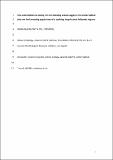Fine-scale habitat use during the non-breeding season suggests that winter habitat does not limit breeding populations of a declining long-distance Palearctic migrant
Date
11/2015Metadata
Show full item recordAbstract
For migrant birds, what habitats are suitable during the non-breeding season influences habitat availability, population resilience to habitat loss, and ultimately survival. Consequently, habitat preferences during winter and whether habitat segregation according to age and sex occurs directly influences migration ecology, survival and breeding success. We tested the fine-scale habitat preferences of a declining Palearctic migrant, the Whinchat Saxicola rubetra, on its wintering grounds in West Africa. We explored the influence of habitat at the territory-scale and whether dominance-based habitat occupancy occurs by describing the variation in habitat characteristics across wintering territories, the degree of habitat change within territories held throughout winter, and whether habitat characteristics influenced territory size and space-use within territories or differed with age and sex. Habitat characteristics varied substantially across territories and birds maintained the same territories even though habitat changed significantly throughout winter. We found no evidence of dominance-based habitat occupancy; instead, territories were smaller if they contained more perching shrubs or maize crops, and areas with more perching shrubs were used more often within territories, likely because perches are important for foraging and territory defence. Our findings suggest that Whinchats have non-specialised habitat requirements within their wintering habitat of open savannah and farmland, and respond to habitat variation by adjusting territory size and space-use within territories instead of competing with conspecifics. Whinchats show a tolerance for human-modified habitats and results support previous findings that some crop types may provide high-quality wintering habitat by increasing perch density and foraging opportunities. By having non-specialised requirements within broad winter habitat types, migrants are likely to be flexible to changing wintering conditions in Africa, both within and across winters, so possibly engendering some resilience to the rapid anthropogenic habitat degradation occurring throughout their wintering range.
Citation
Blackburn , E & Cresswell , W 2015 , ' Fine-scale habitat use during the non-breeding season suggests that winter habitat does not limit breeding populations of a declining long-distance Palearctic migrant ' , Journal of Avian Biology , vol. 46 , no. 6 , pp. 622-633 . https://doi.org/10.1111/jav.00738
Publication
Journal of Avian Biology
Status
Peer reviewed
ISSN
0908-8857Type
Journal article
Description
Date of Acceptance: 23/05/2015Collections
Items in the St Andrews Research Repository are protected by copyright, with all rights reserved, unless otherwise indicated.

